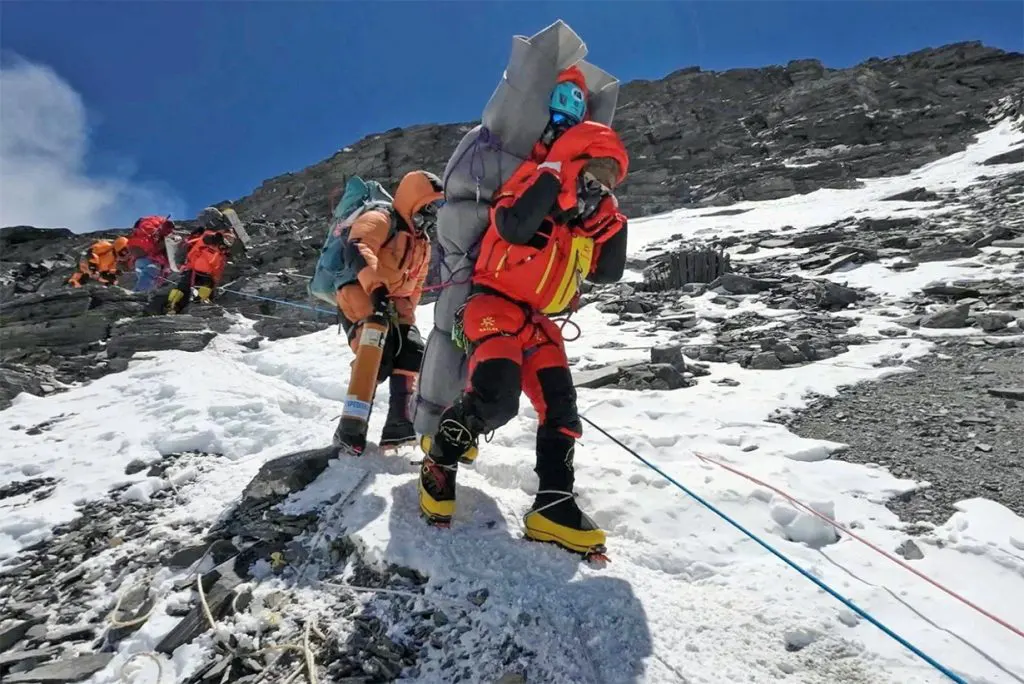A 30-year-old Gelje Sherpa from Solukhumbu rescued a Malaysian mountaineer stranded near the “Death Zone” of Mt. Everest. Gelje Sherpa, known as “Ravi” among the team, rescued the Malaysian mountaineer near the South Pole. It is considered impossible to rescue anyone from this area on Mt. Everest. The tourism department officials have referred to Gelje Sherpa’s rescue as a “miracle.”
Gelje Sherpa, a resident of ward No. 10 in Solu Dudhkunda Municipality, guides the expedition company. Gelje is a renowned figure, often called the “Killer Mountain,” due to his remarkable accomplishments in scaling challenging peaks. Last year, Gelje was part of a 10-member Nepali team, including Nirmal Purja, who completed the first winter ascent of K2, the world’s second-highest mountain, and became the first to join hands and kiss the summit as a tribute to the late mountaineer.
In May last year, Gelje led a Chinese mountaineer to the top of Mt. Everest. He single-handedly rescued a Malaysian mountaineer stranded at approximately 8,300 meters in the Death Zone.
“I saw a person stranded alone on the trail. He was shivering in the cold and trembling with fear. No one else seemed to be aware of his presence,” Gelje Sherpa shared with an online news outlet. He continued, “I approached him carefully. I brought him down as far as Camp IV, securing him with a black sleeping mat, tying him with a rope, and attaching a harness to his back, just like a baby on my back. There were other companions at the camp.”
According to Gelje, the stranded climber was a Malaysian citizen. He was referred to as “Ravi” by the team members. After successfully climbing Mt. Everest, when Gelje was returning, he encountered the helpless climber stranded due to exhaustion. Gelje said, “I canceled my ascent because rescuing him was my priority. Money can be earned later.”
A video of Gelje Sherpa carrying the stranded climber on his back has been circulating on social media. The Malaysian mountaineer was airlifted from Camp III by helicopter and taken to Kathmandu for treatment.

Typically, guides on Mount Everest leave their team members and focus on the well-being of their group. However, Gelje Sherpa left the Chinese team he was climbing with and rescued a member from another team.
Gelje mentioned that the Chinese team disagreed with rescuing the Malaysian climber after he intervened. He said, “I understood I had to go for the rescue while the Chinese didn’t. Later, they also understood.”
During the rescue operation, Nimatas Sherpa assisted Gelje.
According to Gelje, the condition of the Malaysian citizen was not good when he found him. He said, “He was vulnerable, trembling, and shivering. Later, his companions informed me that they had rescued him by helicopter and brought him to Kathmandu.” A few days later, Gelje received a message on his mobile phone saying, “Thank you for saving me.”
The message was from the Malaysian citizen himself. Gelje expressed his happiness upon hearing that the climber was safe, saying, “I felt thrilled when I knew he had survived. He has returned to his country after receiving treatment in Kathmandu.”
During that time, Gelje experienced a profound sense of merit. As a follower of the Buddhist faith, Gelje expressed happiness to an online news outlet, saying, “It is much more meritorious to lead a life that benefits others than merely performing religious rituals in temples or monasteries.”
This is truly a miraculous rescue.
According to the officials from the Mountaineering Section of the Tourism Department, it is nearly impossible to rescue someone from above “Camp 2”.
“It is scarce to rescue someone from above Camp 2. This can be considered a miracle,” Koirla stated. “Galjel has gone through a great ordeal. We are amazed.”
According to Koirla, Galjel was rescued from South Col. According to him; South Col is located at an altitude of 7,900 meters in the Everest region. The area above it, known as the South Summit Balcony, is more than 8,400 meters above sea level. This area is even more dangerous. Many climbers have lost their lives in this region.
According to Koirla, an official from the Mountaineering Section of the Tourism Department, in this season alone, there have been 12 fatalities during Mount Everest expeditions, and five individuals are missing. The number of climbers who have reached the summit of Everest is around 600.
